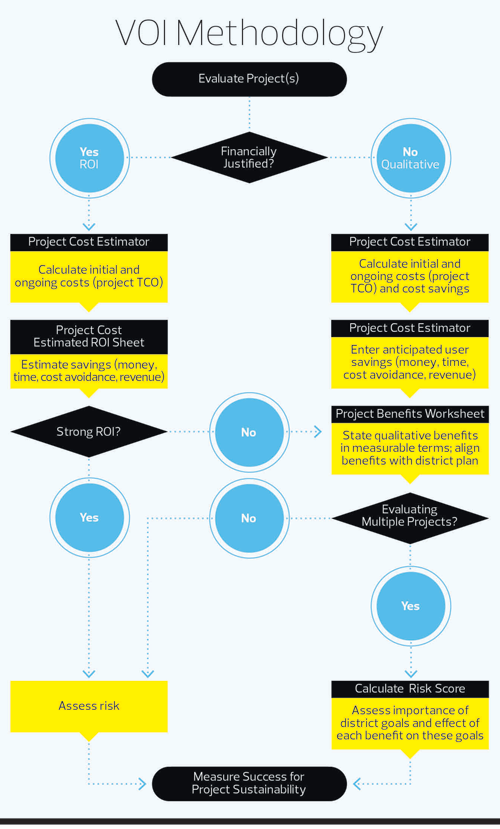When It Comes to IT Investments, Think Value, Not Return
Return on investment and net present value are common concepts used in business to determine how best to invest in technology to lower bottom-line costs and increase revenues. Both are helpful because businesses seek to maximize profits, after all. If this approach were applicable to school districts, the decision-making process for proposed technology projects would be much easier and more objective.
But profit maximization isn't the goal of our nation's schools. Rather, schools must focus on providing students the best possible education, and investments need to show value toward accomplishing that mission.
Without question, reducing costs by using technology efficiently makes sense in schools, as it does in the business world. Monies saved through efficiencies can free up resources for the organization's critical goals. Therefore, it's important for districts to determine the expected ROI for such projects.
But for most major IT investment opportunities in a K–12 environment, the critical return can't be measured in dollars and cents. These proposed projects should be measured in terms of cost and benefits — the intrinsic value that the initiative will bring in carrying out the district's mission.
At the Consortium for School Networking, we call this the value of investment — or VOI.
Measuring VOI
VOI is a cost versus benefit analysis that can be used to:
- Evaluate projects competing for funding to determine which project offers the best cost/benefit value
- Convince constituents that the investment should be made by conveying specific achievable benefits relating to the school's mission
- Articulate purpose for project implementation and educate participants and constituents
- Sustain the project in the future to review actual costs and benefits when the time comes to refresh equipment or answer to skeptics
The two components of VOI in the K–12 sector include monetary benefits (such as cost savings) and qualitative benefits that are oriented to district or school missions, goals and mandates. But VOI is about more than just articulating costs and benefits. K–12 institutions should calculate and closely evaluate costs, savings and revenues; "qualitative" benefits; risks; and the investment's impact and effectiveness.
Although this task can be challenging, there are, in fact, publicly available methodologies — including guidance and tools through CoSN's Value of Investment leadership initiative — that school leaders can follow to accurately and consistently measure VOI.
To calculate VOI, follow this five-step process:
1. Estimate Project Costs (Project Total Cost of Ownership):
To properly implement and support the IT project, all initial and ongoing direct costs should be budgeted. However, to determine the relative value of the proposed project, budgeted costs should be annualized and indirect costs (user overhead time) should be considered; these combined annualized costs constitute the project's Total Cost of Ownership (see "VOI Methodology").
2. Calculate Anticipated Savings and Revenues:
Most projects — even those focused on qualitative benefits such as student achievement — have cost savings: lower out-of-pocket costs, better user productivity, future cost avoidance or increased revenue, for example. Also, for projects designed primarily to save money or enhance staff productivity, an ROI calculator is provided within CoSN's VOI Project Cost Estimator tool (at cosn.org/VOIMethodologyTools).
3. Measure (Score) "Qualitative" Benefits:
The nonfinancial benefits are qualitative, and can be measured and tied to the district's strategic plan, mission, goals and mandates
Here is a suggested approach for calculating these anticipated benefits:
- Determine the school's or district's mission, goals and mandates, and assign a relative importance to each.
- Align anticipated project benefits with the appropriate school mission, goals and mandates.
- State the anticipated project benefits in measurable terms.
If you aren't comparing two or more projects competing for funds, the next steps don't apply. Otherwise, it helps to score each of the competing projects:
- Agree on the effect of each of the proposed project benefits on applicable mission statements, goals and mandates, and the relative importance of those goals.
- Calculate a total qualitative benefits score for each project.
4. Assess Risk:
Risk, as understood for the purpose of VOI calculations, is more appropriately viewed as the probability of success for the proposed project. This is applied to the valuation of the project's expected benefits (see "Sample Project Benefit Categories").
5. Evaluate Results:
Was the project worth it? Once a technology project has been implemented, district leaders have an opportunity to objectively review actual costs and benefits against the projected costs and measurable benefits.
A Proven Effort
Performing a VOI evaluation may seem like a lot of work, and it shouldn't be applied to small projects. However, it's a critical step in developing understanding, direction and clarity for proposed large technology undertakings.
The calculation of VOI has been used, for example, to help a district engage its community and then pass (after previous failures) a bond for a one-to-one notebook computer initiative. It allowed another district to realize that a proposed online learning initiative originally intended to delay a major building expansion actually supported a major mission statement ("Our students will be lifelong learners."). VOI also helped school leaders in another district more clearly define the benefits of their mobile learning pilot to better guide districtwide rollouts in the future.
Be sure to focus on the value of investments in educational technology now — before your school moves past a point of no return.
Sample Project Benefit Categories
- Financial — cost savings, productivity, cost avoidance, increased revenue
- Student achievement/success
- Student equity
- Student behavior and social growth
- Teachers and administrative staff
- Political value
- Community goodwill
- Safety and security
- Curricula and course options
- 21st century skills or college and career readiness








